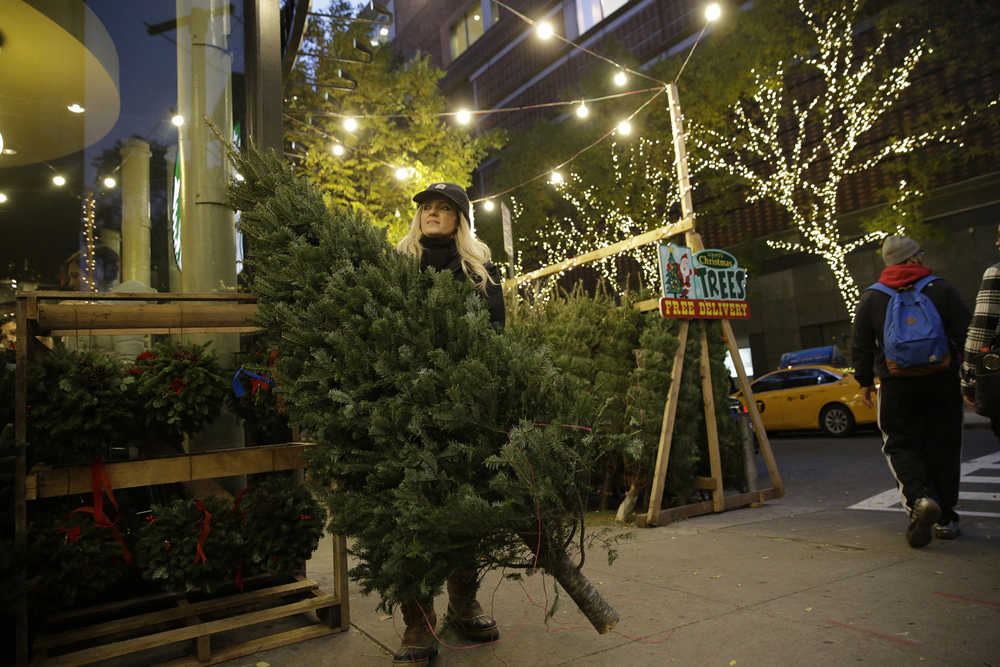NEW YORK — In New York City, even sidewalk space is coveted real estate. Street vendors sometimes spend a fortune or languish for years on waiting lists to acquire one of the permits that allow them to sell goods in tightly regulated locations.
But once a year, there’s an exception, laid out in an artfully worded city ordinance: During the month of December, anyone may sell “coniferous trees” just about anywhere — no license required.
It’s a rare tree-for-all. Peddlers flock in from across North America. Big trucks carrying huge loads of trees arrive in the dead of night. Stands selling coniferous trees (some people, but not the city, call them Christmas trees) sprout everywhere.
The annual tree ritual brings New Yorkers together on village-like corners abuzz with neighborly chatter amid twinkling lights.
“I like to walk through the smell,” says Tim Albright, a customer taking a deep whiff of a cluster of trees this week.
And then there’s that other special green attraction: the smell of money that comes with the right to operate tree stands 24-7, free of charge, no license needed. That lures hardy entrepreneurs like Tom Gilmartin, a 62-year-old commercial fishing captain from Alaska.
He rolled into town with his wife and 12-year-old son in a pickup truck with a red-and-green camper perched on the back.
That’s where they’ll be sleeping for the next few weeks, parked next to the Manhattan stand they’ve operated every season for two decades. A giant Santa Claus standing on the truck’s roof helps lure customers. Gilmartin and his wife take turns doing 12-hour shifts and shower at a local hostel in return for a donated tree.
They sell up to 500 trees each season, averaging an income of about $14 per hour. Their prize sale so far has been a 17-foot, $700 Fraser.
Their son, Rory, earned $1,200 on a recent weekend delivering trees on a three-wheeled stroller. He gets $20 per delivery.
“You can’t just sell trees,” Tom Gilmartin said. “You have to make friends. That’s what this business is all about.”
They might not be in New York if it weren’t for the unlicensed vending, which has an intriguing history.
In 1938, Mayor Fiorello La Guardia waged what became known as his “War on Christmas” — an effort to keep mostly immigrant vendors off the streets by forcing them to obtain licenses.
So few were issued that trees vanished, causing an uproar. That’s when the City Council enacted an exception allowing vendors free access to sidewalks once a year to sell Christmas trees, so long as adjoining store owners give their consent and the operation doesn’t block pedestrians. The city later changed the text of the law to apply to coniferous trees, rather than Christmas trees, to avoid the appearance of giving special treatment to one religious group.
There are a few other carve-outs in New York’s licensing schemes for street vendors, including an easing of some regulations for veterans and a waiver of permits, on free speech grounds, for people selling books.
On the flip side, some hot dog pushcart owners paid the city $200,000 or more in concession fees for the right to operate in a prime spot in Central Park. For a two-year street vending license, the city charges $200 — but they’re so scarce that legal permit holders often “lease” them out to other vendors for tens of thousands of dollars.
Christmas tree sellers have an easier time, but they also hold on to their territory. Laura Miller has been working the same corner on Manhattan’s Upper West Side for a decade.
The 40-year-old, who is five months pregnant, can be spotted from afar, her blonde hair cascading down her shoulders under a warm hat. The cold is no problem; she grew up in the Siberian city of Omsk, where she was a chorus conductor.
Now a Florida resident, she does office work the rest of the year and stays with friends during her winter stint in New York.
“I have a lot of competition now in New York, for sure, because just about every corner is trying to sell Christmas trees,” Miller said. “It can be so crazy.”
But ever the saleswoman, Miller quickly touts the quality of her fine firs.
“Basically,” she said, “I have the best.”

